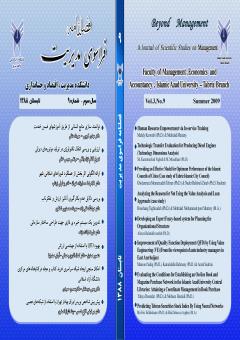توانمندسازی منابع انسانی از طریق آموزش های ضمن خدمت
الموضوعات : Business Management
1 - استادیار گروه جهانگردی دانشگاه علامه طباطبایی تهران
2 - عضو هیأت علمی گروه مدیریت،واحد قائمشهر، دانشگاه آزاد اسلامی ،قائمشهر،ایران
الکلمات المفتاحية: عملکرد, منابع انسانی, توانمندسازی, آموزش ضمن خدمت, مهارتهای شغلی,
ملخص المقالة :
امروزه توانمندسازی به عنوان یکی از ابزارهای مفید ارتقاء کیفی کارکنان و افزایش اثربخشی سازمانی تلقی می گردد. به منظور کسب موفقیت در محیط در حال تغییر کسب و کار امروزی، سازمانها به دانش، نظرات و خلاقیت کارکنان نیازمندند. در این مقاله نیز پس از تعریف توانمندسازی و اهداف آن به بررسی دیدگاههای کارکنان درباره افزایش توانمندیهای شغلی کارکنان از طریق آموزش های ضمن خدمت می پردازد. روش تحقیق توصیفی از نوع پیمایشی است. نمونه آماری این پژوهش تعداد 103 نفر از کارکنان دانشگاه آزاد اسلامی مازندران هستند که به شیوه نمونه گیری طبقه ای انتخاب شده اند. ابزار گردآوری داده ها پرسشنامه به شیوه بسته پاسخ با طیف لیکرت بوده و برای تجزیه و تحلیل داده ها از آزمون "t" تک متغیره و تحلیل واریانس استفاده شده است. نتایج نشان داد که آموزش های ضمن خدمت در بهبود عملکرد، تقویت مهارت های شغلی، رضایت شغلی و آمادگی لازم برای انجام وظایف در کارکنان مؤثر بوده است. همچنین یافته ها حاکی از آن است که بین میانگین اثربخشی به دست آمده در دو گروه مردان و زنان تفاوت معناداری وجود دارد. همچنین بین میانگین های به دست آمده در سه گروه با سوابق خدمتی 5 تا 10 سال، 10 تا 15 سال و بالای 15 سال تفاوت مشاهده می گردد.
Aghayar, S. (2003). Empowerment of the New Method in a Competitive Environment. Tadbir Monthly, 135, (In Persian).
Blanchard, K., Carlos, J. P., & Randolph, A. (1996). Empowerment takes more than a minute. Sanfaroncisco: Barrett Koehler publishing.
Conger, J. A., & Konugo, R. (1988). The Empowerment Process: Integrating theory and Practice, Academy of Managemet Review, 13(3), 471-482.
Fathi Ojargah, K. (2004). Employee Training Planning. Tehran: Samt Publication, (In Persian).
Hassanzadeh, R. (2003). Research Methods in Behavioral Sciences. Tehran: Savalan, (In Persian).
Jafarzadeh, R. (2007). Transitional Model in Effective Assessment of Staff Training. Tadbir Magazine, 86, (In Persian).
Kenila, D. (2004). Empowerment of Human Resources. Translated by: M., Irannejad Parizi, & M. A., Selimian, Tehran: Iran Publishing, (In Persian).
Khatibi, A., Asgari, L., Naderi, H., & Kafash, A. (2002). A Survey on Employees Training System and Its Effect on Increasing Efficiency in Zanjan University of Medical Sciences, (In Persian).
Lampers, B. (2004). 10 Strategies for staff empowerment. Reston, 4.
Lee, M. J., & Keh, J. (2000). Is Empowerment Really a New Concept?. The International Journal of Human Resource Management, 18(14).
Lippin, T. M. (2001). Empowerment Base Health and Safety Training & Development. Alexandria, 5(7).
Metani, M. (2007). The Basics of Research Methods in Management. Babol: Mabas Publication, (In Persian).
Mohammadi, M. (2001). Human Resources Empowerment. Motaleate Modiriyyat Quarterly, 31 & 32, (In Persian).
Pak Tinat, I. (2008). Empowerment of Employees; Needs and Solutions. Modiriyyat Quarterly, 11, (In Persian).
Pasha Sharifi, H., & Nafizzand, J. (1988). Statistical Methods in Behavioral Sciences. Tehran: Sokhan, (In Persian).
Quinn, R. E., & Gretchen, M. S. (1997). The road to empowerment: Seven questions every leader should consider organaziational dynami. 2(2), 37-51.
Raziei, S. (2005). Exploring and Explaining the Factors Affecting on the Human Resource Empowerment in Oil Exploration Company, (In Persian).
Savage, S. (2001). Empowerment. Available at: http://faculty.valencia.cc.us.
Scott, S., & Denise, J. (1996). Staff Empowerment. Translated by: M., Irannejad Parizi, Tehran: Development of Research and Management Training, (In Persian).
_||_
Aghayar, S. (2003). Empowerment of the New Method in a Competitive Environment. Tadbir Monthly, 135, (In Persian).
Blanchard, K., Carlos, J. P., & Randolph, A. (1996). Empowerment takes more than a minute. Sanfaroncisco: Barrett Koehler publishing.
Conger, J. A., & Konugo, R. (1988). The Empowerment Process: Integrating theory and Practice, Academy of Managemet Review, 13(3), 471-482.
Fathi Ojargah, K. (2004). Employee Training Planning. Tehran: Samt Publication, (In Persian).
Hassanzadeh, R. (2003). Research Methods in Behavioral Sciences. Tehran: Savalan, (In Persian).
Jafarzadeh, R. (2007). Transitional Model in Effective Assessment of Staff Training. Tadbir Magazine, 86, (In Persian).
Kenila, D. (2004). Empowerment of Human Resources. Translated by: M., Irannejad Parizi, & M. A., Selimian, Tehran: Iran Publishing, (In Persian).
Khatibi, A., Asgari, L., Naderi, H., & Kafash, A. (2002). A Survey on Employees Training System and Its Effect on Increasing Efficiency in Zanjan University of Medical Sciences, (In Persian).
Lampers, B. (2004). 10 Strategies for staff empowerment. Reston, 4.
Lee, M. J., & Keh, J. (2000). Is Empowerment Really a New Concept?. The International Journal of Human Resource Management, 18(14).
Lippin, T. M. (2001). Empowerment Base Health and Safety Training & Development. Alexandria, 5(7).
Metani, M. (2007). The Basics of Research Methods in Management. Babol: Mabas Publication, (In Persian).
Mohammadi, M. (2001). Human Resources Empowerment. Motaleate Modiriyyat Quarterly, 31 & 32, (In Persian).
Pak Tinat, I. (2008). Empowerment of Employees; Needs and Solutions. Modiriyyat Quarterly, 11, (In Persian).
Pasha Sharifi, H., & Nafizzand, J. (1988). Statistical Methods in Behavioral Sciences. Tehran: Sokhan, (In Persian).
Quinn, R. E., & Gretchen, M. S. (1997). The road to empowerment: Seven questions every leader should consider organaziational dynami. 2(2), 37-51.
Raziei, S. (2005). Exploring and Explaining the Factors Affecting on the Human Resource Empowerment in Oil Exploration Company, (In Persian).
Savage, S. (2001). Empowerment. Available at: http://faculty.valencia.cc.us.
Scott, S., & Denise, J. (1996). Staff Empowerment. Translated by: M., Irannejad Parizi, Tehran: Development of Research and Management Training, (In Persian).


